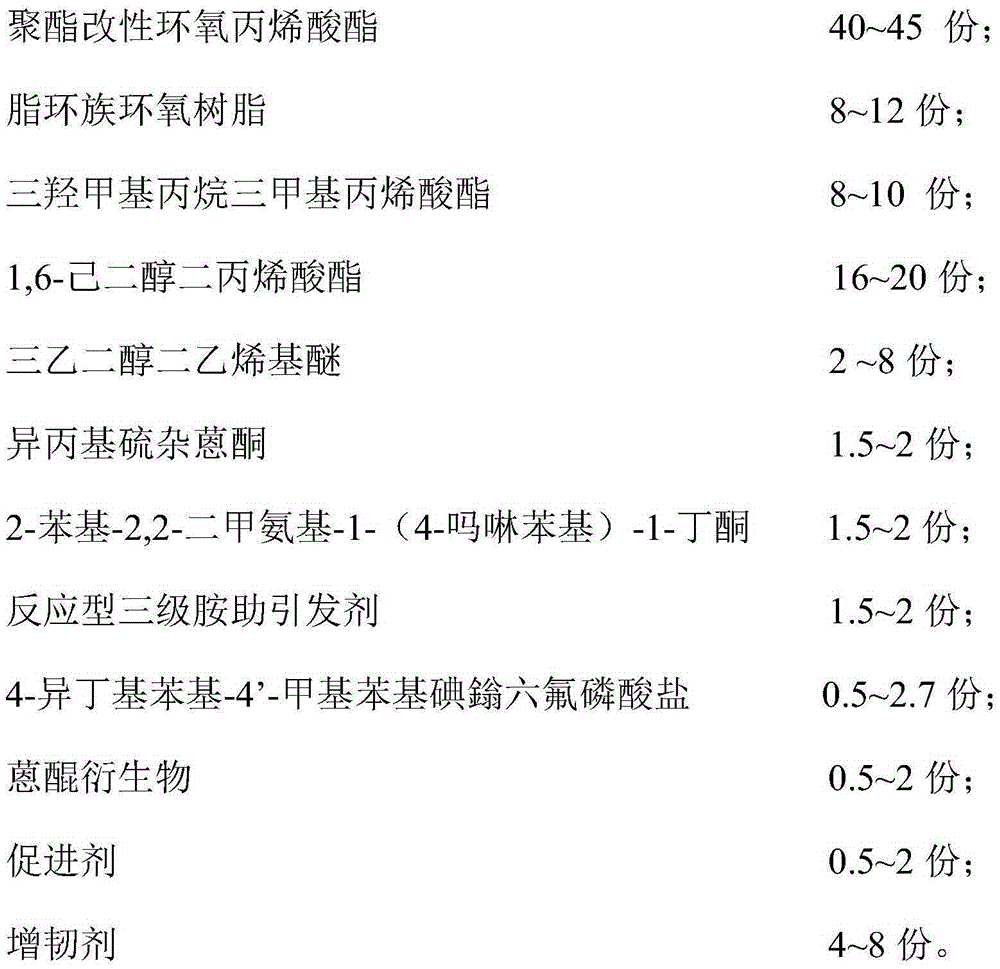Light-cured three dimensional printing material and preparation method thereof
A 3D printing and light curing technology, applied in the field of polymer composite materials, can solve problems such as deformation of cured products, restrictions on the promotion and use of 3D printing technology, and difficulties in the movement of the main chain, and achieve the effect of improving the forming accuracy
- Summary
- Abstract
- Description
- Claims
- Application Information
AI Technical Summary
Problems solved by technology
Method used
Image
Examples
Embodiment 1
[0018] 1. In parts by mass, prepare raw materials as shown in Table 1.
[0019] Table 1 Embodiment 1 each raw material proportioning
[0020] raw material
Example 1
Polyester Modified Epoxy Acrylate
40 copies
Aliphatic epoxy resin
12 copies
Trimethylolpropane trimethacrylate
8 servings
20 copies
Triethylene glycol divinyl ether
2 copies
2 copies
2-Phenyl-2,2-dimethylamino-1-(4-morpholinephenyl)-1-butanone
1.5 servings
Reactive tertiary amine co-initiator 6420
2 copies
4-Isobutylphenyl-4'-methylphenyliodonium hexafluorophosphate
1.5 servings
Sensitizer anthraquinone derivative PAS-12
2 copies
Accelerator Polyol PAS-33
1 copy
Toughener epoxidized hydroxyl-terminated polybutadiene EHTPB
8 servings
[0021] 1.1 Preparation method:
Embodiment 2
[0031] 2. In parts by mass, prepare raw materials as shown in Table 3
[0032] Table 3 embodiment 2 each raw material ratio
[0033] raw material
Example 2
Polyester Modified Epoxy Acrylate
43.5 servings
Aliphatic epoxy resin
9 servings
Trimethylolpropane trimethacrylate
9 servings
18 copies
Triethylene glycol divinyl ether
5 copies
1.5 servings
2-Phenyl-2,2-dimethylamino-1-(4-morpholinephenyl)-1-butanone
2 copies
Reactive tertiary amine co-initiator
1.7 servings
4-Isobutylphenyl-4'-methylphenyliodonium hexafluorophosphate
0.5 parts
Sensitizer anthraquinone derivative PAS-12
1.8 servings
Accelerator Polyol PAS-33
2 copies
Toughener epoxidized hydroxyl-terminated polybutadiene EHTPB
6 servings
[0034] 2.1 Preparation method:
[0035] A) In parts by mass, 18 parts of diluent 1,6-he...
Embodiment 3
[0044] 3. In parts by mass, prepare raw materials as shown in Table 5
[0045] Each raw material ratio of table 5 embodiment 3
[0046] raw material
[0047] 3.1 Preparation method:
[0048] A) In parts by mass, 16 parts of diluent 1,6-hexanediol diacrylate, 10 parts of trimethylolpropane trimethacrylate and 8 parts of triethylene glycol divinyl ether, photoinitiator 1.9 parts of isopropylthioxanthone, 1.9 parts of 2-phenyl-2,2-dimethylamino-1-(4-morpholinephenyl)-1-butanone and 4-isobutylphenyl-4 2.7 parts of '-methylphenyl iodonium hexafluorophosphate, 1.5 parts of reactive tertiary amine co-initiator, 0.5 part of sensitizer anthraquinone derivative and 0.5 part of accelerator polyol compound are added to the beaker and heated Stir on a magnetic stirrer for 2 hours.
[0049] B) In terms of parts by mass, add 45 parts of prepolymer polyester modified epoxy acrylate, 8 parts of alicyclic epoxy resin and 4 parts of toughening agent epoxidized hydroxyl-terminated po...
PUM
| Property | Measurement | Unit |
|---|---|---|
| flexural modulus | aaaaa | aaaaa |
| elongation at break | aaaaa | aaaaa |
| tensile strength | aaaaa | aaaaa |
Abstract
Description
Claims
Application Information
 Login to View More
Login to View More - R&D
- Intellectual Property
- Life Sciences
- Materials
- Tech Scout
- Unparalleled Data Quality
- Higher Quality Content
- 60% Fewer Hallucinations
Browse by: Latest US Patents, China's latest patents, Technical Efficacy Thesaurus, Application Domain, Technology Topic, Popular Technical Reports.
© 2025 PatSnap. All rights reserved.Legal|Privacy policy|Modern Slavery Act Transparency Statement|Sitemap|About US| Contact US: help@patsnap.com


